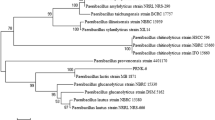Abstract
Pseudomonas alcaligenes strain PA-10 degrades thefour-ring polycyclic aromatic hydrocarbon fluoranthene, co-metabolically. HPLC analysisof the growth medium identified four intermediates, 9-fluorenone-1-carboxylicacid; 9-hydroxy-1-fluorene carboxylic acid; 9-fluorenone and 9-fluorenol, formedduring fluoranthene degradation. Pre-exposure of PA-10 to 9-fluorenone-1-carboxylic acidand 9-hydroxy-1-fluorene-carboxylic acid resulted inincreases in fluoranthene removal, while pre-exposure to9-fluorenone and 9-fluorenol resulted in a decrease influoranthene degradation. The rate of indole transformation was similarly affected by pre-exposureto these metabolic intermediates, indicating a link between fluoranthenedegradation and indigo formation in this strain.
Similar content being viewed by others
References
Bhushan B,Samanta SK &Jain RK (2000) Indigo production by naphthalene-degrading bacteria. Lett. Appl. Microbiol. 31: 5-9
Boldrin B,Tiehm A &Fritzsche C (1993) Degradation of phenanthrene, fluorene, fluoranthene and pyrene by a Mycobacterium sp. Appl. Environ. Microbiol. 59: 1927-1930
Bos RP (1987) Fluoranthene, a carcinogen? Mutat. Res. 189: 187.
Bos RP,Prinsen WJC,van Rooy JGM,Jongeneelen FJ,Theuws JLG &Henderson PTh (1987) Fluoranthene, a volatile mutagenic compound, present in creosote and coal tar. Mutat. Res. 187: 119-125
Bradford MM (1976) A rapid and sensitive method for the quantitation of microgram quantities of protein utilizing the principle of protein-dye binding. Anal. Biochem. 72: 248-254
Casellas M,Grifoll M,Bayona JM &Solanas AM (1997) New metabolites in the degradation of fluorene by Arthrobacter sp. strain F101. Appl. Environ. Microbiol. 63: 819-826
Cerniglia CE &Heitkamp MA (1989) Microbial degradation of polycyclic aromatic hydrocarbons (PAH) in the aquatic environment. In Varanasi U (ed) Metabolism of polycyclic aromatic hydrocarbons in the aquatic environment (pp 41-68). CRC Press, Inc., Boca Raton, FL
Cerniglia CE (1992) Biodegradation of polycyclic aromatic hydrocarbons. Biodegradation 3: 351-368
Cerniglia CE (1993) Biodegradation of polycyclic aromatic hydrocarbons. Curr. Opin. Biotechnol. 4: 331-338
Chen S &Aitken MD (1999) Salicylate stimulates the degradation of high-molecular weight polycyclic aromatic hydrocarbons by Pseudomonas saccharophilia P15. Environ. Sci. Technol. 33: 435-439
Churchill SA,Harper JP &Churchill PF (1999) Isolation and characterisation of a Mycobacterium species capable of degrading three-and four-ring aromatic and aliphatic hydrocarbons. Appl. Environ. Microbiol. 65: 549-552
Ensley BD,Ratzkin BJ, Osslund TD,Simon MJ,Wackett LP &Gibson DT (1983) Expression of naphthalene oxidation genes in Escherichia coli results in the biosynthesis of indigo. Science 222: 167-169
Gordon L.M. (2001) Physiology and genetics of fluoranthene degradation in Pseudomonas alcaligenes PA-10. PhD Thesis, National University of Ireland, Cork.
Gordon LM &Dobson ADW (2002) Isolation and characterisation of a gene encoding a novel oxygenase from the fluoranthene degrading strain Pseudomonas alcaligenes PA-10 (manuscript in preparation)
Heitkamp MA,Franklin W &Cerniglia CE (1988) Microbial metabolism of polycyclic aromatic hydrocarbons: isolation and characterisation of pyrene-degrading bacterium. Appl. Environ. Microbiol. 54: 2549-2555
Heitkamp MA,Freeman JP Miller DW &Cerniglia CE (1988) Pyrene degradation by a Mycobacterium sp.: identification of ring oxidation and ring fission products. Appl. Environ. Microbiol. 54: 2556-2565
Juhasz AL &Naidu R (2000) Bioremediation of high molecular weight polycyclic aromatic hydrocarbons: a review of the microbial degradation of benzo[a]pyrene. Int. Biodet. Biodeg. 45: 57-88
Kanaly RA & Harayama S (2000) Biodegradation of highmolecular-weight polycyclic aromatic hydrocarbons by bacteria. J. Bacteriol. 182: 2059-2067
Keil H,Saint CM &Williams PA (1987) Gene organization of the first catabolic operon of TOL plasmid pWW53: production of indigo by the xylA gene product. J. Bacteriol. 169: 764-770
Kelley I,Freeman JP,Evans FE &Cernglia CE (1991) Identification of a carboxylic acid metabolite from the catabolism of fluoranthene by a Mycobacterium sp. Appl. Environ. Microbiol. 57: 636-641
Kelley I,Freeman JP,Evans FE &Cernglia CE (1993). Identification of metabolites from the degradation of fluoranthene by Mycobacterium sp. strain PYR-1. Appl. Environ. Microbiol. 59: 800-806
Mahaffey WR,Gibson DT &Cerniglia CE (1988) Bacterial oxidation of chemical carcinogens: formation of polycyclic aromatic acids from benzo[a]anthracene. Appl. Environ. Microbiol. 54: 2415-2423
Mermot N,Harayama S &Timmins KT (1986) New route to bacterial production of indigo. Bio/Technology 4: 321-324
O'Connor KE,Dobson ADW &Hartmans S (1997) Indigo formation by microorganisms expressing styrene monooxygenase activity. Appl. Environ. Microbiol. 63: 4287-4291
Rehmann, K,Hertkorn N &Kettrup AA (2001) Fluoranthene metabolism in Mycobacterium sp. strain KR20: identity of pathway intermediates during degradation and growth. Microbiology 147: 2783-2794
Rummel AM,Trosko JE,Wilson MR &Upham BL (1999) Polycyclic aromatic hydrocarbons with bay-like regions inhibited gap-junctional intercellular communication and stimulated MAPK activity. Toxicol. Sci. 49, 232-240
Sepic E,Bricelj M &Leskovesk H (1998) Degradation of fluoranthene by Pasteurella sp. IFA and Mycobacterium sp. PYR-1: isolation and identification of metabolites. J. Appl. Microbiol. 85: 746-754
Weissenfels WD,Beyer M,Klein J &Rehm HJ (1991) Microbial metabolism of fluoranthene: isolation and identification of ring fission products. Appl. Microbiol. Biotechnol. 34: 528-535
Ye D,Siddiqi MA,Maccubbin AE,Kumar S &Sikka HC (1996) Degradation of polynuclear aromatic hydrocarbons by Sphingomonas paucimobilis. Environ. Sci. Technol. 30: 136-142
Yen K-M &Serdar CM (1988) Genetics of naphthalene catabolism in pseudomonads. Crit. Rev. Microbiol. 15: 247-269
Yen K-M,Karl R,Blatt LM,Simon MJ,Winter RB,Fausset PR,Lu HS,Harcourt AA &Chen KK (1992) Cloning and characterisation of a Pseudomonas mendocina KR1 gene cluster encoding toluene dioxygenase. J. Bacteriol. 173: 5315-5327
Author information
Authors and Affiliations
Rights and permissions
About this article
Cite this article
Gordon, L., Dobson, A.D. Fluoranthene degradation in Pseudomonas alcaligenes PA-10. Biodegradation 12, 393–400 (2001). https://doi.org/10.1023/A:1015029519142
Issue Date:
DOI: https://doi.org/10.1023/A:1015029519142




